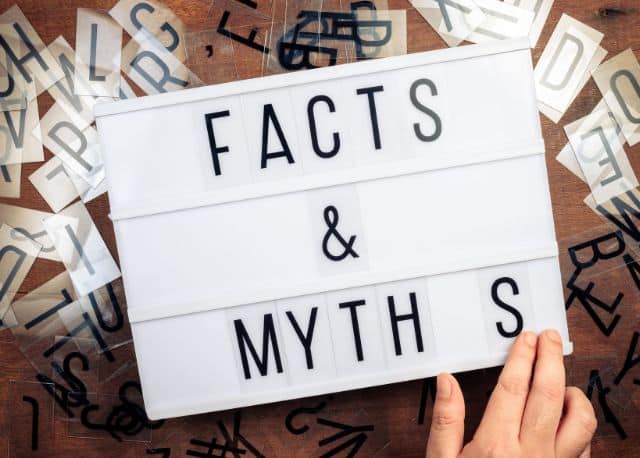Apprenticeships have changed a lot over recent years, but many people and businesses still have preconceptions about them that might not be accurate of today’s schemes, training programmes and qualifications.
In this article, we aim to separate apprenticeship facts from apprenticeship fiction. Whether you’re an individual considering an apprenticeship or an organisation considering employing one, we bust some of the most common myths below.
1. Apprenticeships are only for school leavers
There is no upper age limit for apprenticeships, which means that they can be done by school leavers, graduates, existing employees or those who want a change in career at any stage of life.
In 2019/2020, 47 per cent of the apprenticeships started were by people aged 25 or over.
2. Apprenticeships are for people who don’t do well academically
It’s a fairly common misconception the only people suited to apprenticeships are those who aren’t planning on going to university or other higher or further education. However, a key part of modern apprenticeships is the training and study that accompanies the work, which goes towards a qualification once the programme is completed.
In order to be eligible for an apprenticeship in England, the person must be over the age of 16 and not be in full-time education.
Some apprenticeships may have entry requirements of certain qualifications, depending on the level of apprenticeship, such as at least five GCSE passes, including Maths and English. However, some apprenticeships may enable the apprentice to study for these qualifications at the same time as they complete the apprenticeship programme.
All kinds of different people choose to do apprenticeships, including those who want to study for a degree whilst also working and earning at the same time.
Take a look at this article on apprenticeship vs university for more information.
3. Apprenticeships don’t result in useful qualifications for the apprentice’s future career
Apprenticeships come in various levels, each of which equates to specific qualifications that are equal to either GCSEs, A-levels, a bachelor’s degree or even a master’s degree.
These levels are:
- Intermediate Apprenticeship (Level 2) – Equivalent to GCSE passes at grade A*-C (or 4-9 in the new system)
- Advanced Apprenticeship (Level 3) – Equivalent to A-level passes
- Higher Apprenticeship (Levels 4/5) – Equivalent to a higher education certificate, diploma or foundation degree
- Degree Apprenticeship (Levels 6/7) – Equivalent to a bachelor’s degree (level 6) or a master’s degree (level 7)
In addition to these qualifications, the apprentice also gets valuable work experience under their belt when completing an apprenticeship, which can sometimes put them ahead of other applicants for future job roles.
4. Apprenticeships are only good if you want a career in the trades
It used to be much more the case that apprenticeships were only available in roles where you were training for a trade, such as becoming an electrician, a plumber or heating engineer. However, that simply isn’t the case now.
In England, there are hundreds of different apprenticeship standards, representing over 1,500 different job roles across a huge range of different industries and sectors. That includes everything from the ‘traditional’ apprenticeships in vocational trades, to working in digital, animal care, hair and beauty, design, transport, banking or care services.
5. Apprentices are poorly paid and have limited earning potential
In the first 12 months of an apprenticeship, the employer is required by law to pay them at least the national apprentice rate for the hours they work, including their training time.
This rate is reviewed regularly and is currently (from April 2021) £4.30 an hour. Employers can choose (and many do) to pay more than this.
After the first year of an apprenticeship has been completed, the legally required pay moves to at least the national minimum wage or national living wage, depending on the individual apprentice.
These rates are currently:
- Aged under 18 after the first year of an apprenticeship – £4.42 per hour (which works out at just over £8,504 per year, or just over £708 per month, before deductions, for a 37-hour working week)
- Aged 18-20 after the first year – £6.56 per hour (which works out at just over £12,621 per year, or just over £1,051 per month, before deductions, for a 37-hour working week)
- Aged 21-22 after the first year – £8.36 per hour (which works out at just over £16,084 per year, or just over £1,340, before deductions, for a 37-hour working week)
- Aged 23 or over after the first year – £8.91 per hour (which works out at just over £17,142 per year, or just over £1,428 per month, before deductions, for a 37-hour working week)
Again, employers can pay more than this if they choose and many do. Once an apprentice has completed their programme, there are no limits to potential earnings outside of what is usual for the industry within which they work in future roles.
6. Apprentices are only given the work no one else wants to do
It may once have been the case that new starter apprentices were only trusted with making the tea round, but that is certainly not the case now. An apprentice role is a full-time paid job that also incorporates high-quality training and 74 per cent of employers have reported that apprenticeships have helped their business to improve the quality of their product or service.
Apprentices are valued members of staff who are there not only to learn and gain the skills needed for their future career, but they are also empowered to contribute positively to the business and the workplace culture.
7. Apprentices need a paid day off every week for their training
At least 20 per cent of an apprentice’s working time across the programme should be spent on off-the-job training, studying and assessment, which is organised and run by the employer’s chosen apprenticeship training provider.
The employer pays the normal wage or hourly rate for this time as they would for when the apprentice is at work, but it’s fairly unusual for it to take the form of one day a week away from the workplace.
Many training providers organise the apprenticeship training in several blocks rather than weekly or even monthly. The employer can discuss various requirements they might have with training providers and work out a schedule that is a good option for everyone.
8. After the apprenticeship is completed, an apprentice won’t have a job
According to government research, around 65 per cent of apprentices remain in employment with the same organisation after they have completed their apprenticeship and 85 per cent stay in employment afterward.
The research also shows that around a third of apprentices, on average, receive a promotion within a year of finishing their programme.
9. Apprenticeships are difficult for businesses to manage or administrate
There are certain things that a business needs to do in order to employ an apprentice, but if they already have other employees then the administration of this isn’t usually extensive or complex and a good training partner will also assist organisations with what is required specifically for apprenticeships.
10. Apprenticeships cost businesses more than its worth in value to them
Research shows that hiring apprentices is an effective way to develop talent within your business and grow a motivated, engaged and skilled team of staff.
Government statistics show that 78 per cent of employers with apprentices said that they helped improve productivity, with 86 per cent of employers saying that apprenticeships helped them develop skills relevant to their organisation.
With various government funding available to help pay for training costs, depending on the specific organisation’s circumstances, and potential incentives too, hiring an apprentice is likely to cost less than you might think.
Hopefully, this article has helped to set the record straight over some long-standing misconceptions about apprenticeships and who they are for, or how valuable they can be to both apprentices and employers alike.


